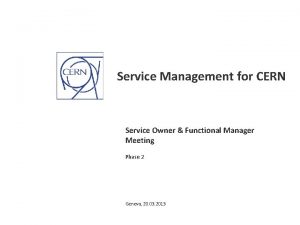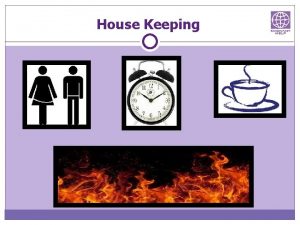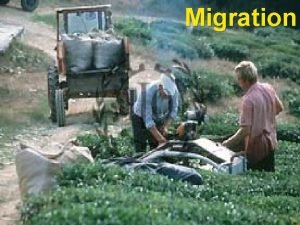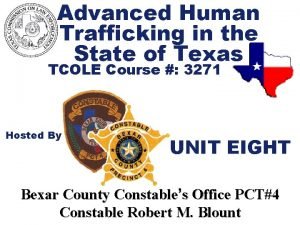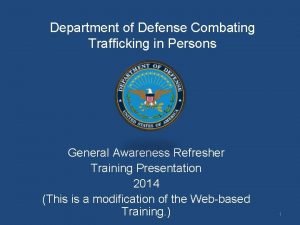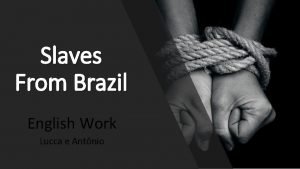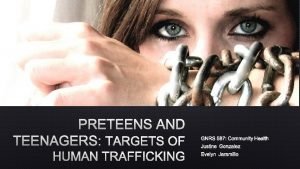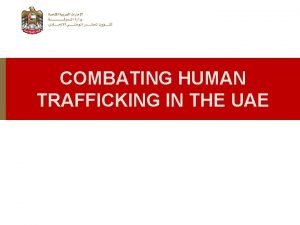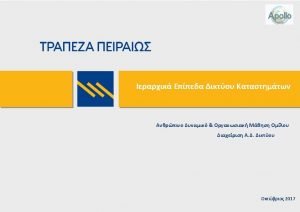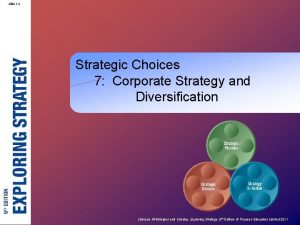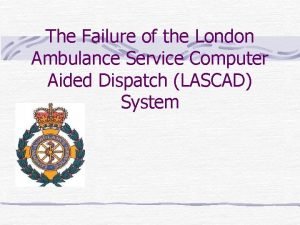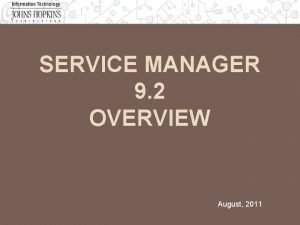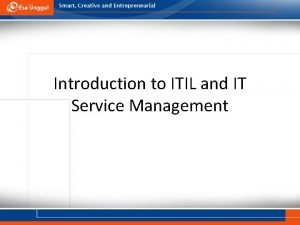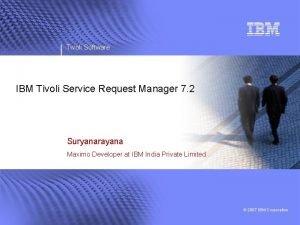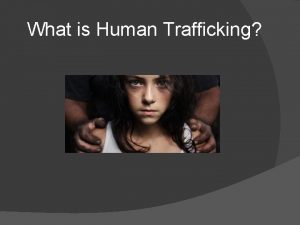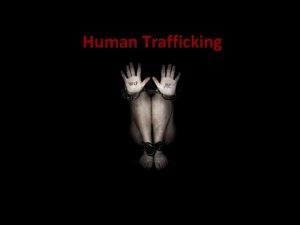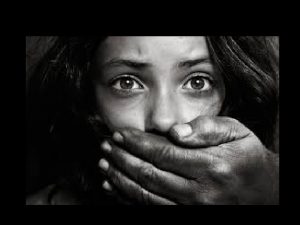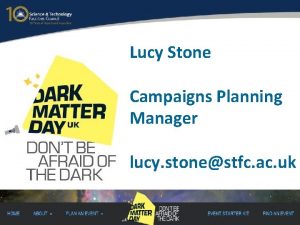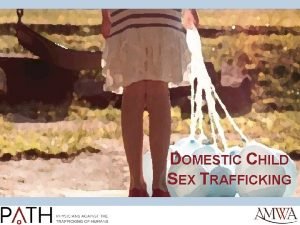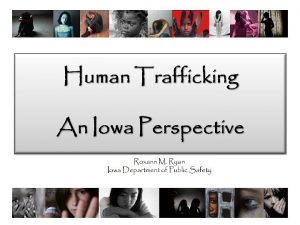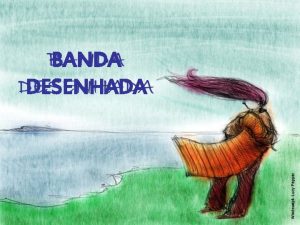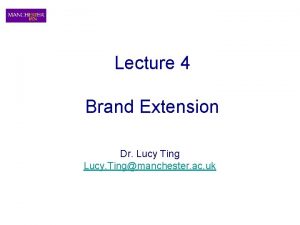Child Trafficking in London Lucy Leon Service Manager



















- Slides: 19

Child Trafficking in London Lucy Leon Service Manager for Trafficking Laurelle Brown Service Manager for Child Sexual Exploitation services The Children’s Society

The Children’s Society in London The Children’s Society have a long history of direct work with young people at risk of sexual exploitation and going missing as well as with vulnerable young refugees and migrants, separated from their families. • Trafficking Service: We set up the Rise Project, a Pan-London specialist trafficking service in 2013 to plug a gap in service provision as over the last ten years, our refugee and migrant projects have seen an increase in the number of boys and young men trafficked to the UK for exploitation. The project offers specialist holistic support for boys and young men aged 11 -25 who have been trafficked to the UK. • Child Sexual Exploitation Services: We run several projects across London to support young people at risk/who have experienced child sexual exploitation, including a specialist service for boys and young men as well as a specialist service for young people with a learning disability. • Missing and Return Home Interview Services: We deliver a wide range of missing and return home interview services across London speaking with young people after they return from a missing episode and sharing safeguarding, intelligence and recommendations to the professional network.

Child Trafficking • Article 3 of the Palermo Protocol defines trafficking as: “Trafficking in persons” shall mean the recruitment, transportation, transfer, harbouring or receipt of persons, by means of the threat or use of force or other forms of coercion, of abduction, of fraud, of deception, of the abuse of power or of a position of vulnerability or of the giving or receiving of payments or benefits to achieve the consent of a person having control over another person, for the purpose of exploitation. ” • The Palermo Protocol establishes children as a special case for whom only two components required - movement and exploitation - because a child can not give consent to being exploited, even if they are aware/agreeable to being moved. • Trafficking of children is child abuse and requires an immediate safeguarding response, due to the high risk of the child/young person being re-trafficked and experiencing trauma and abuse. Many young people who have been trafficked to the UK are re-trafficked shortly after coming into contact with statutory services and are never seen again.

Top ten countries of origin for Minors (NCA Statistics, Jan-March 2016) 1. Vietnam 2. Albania 3. UK 4. Afghanistan 5. Eritrea 6. Nigeria 7. Iran 8. China 9. Bangladesh 10. Iraq

Types of trafficking § Labour exploitation (catering, nail bars, agricultural work, factory work, care homes) § Forced criminal activity (cannabis cultivation, pick-pocketing, ATM/credit card theft, drug dealing, gang-related crime) § Sexual exploitation § Domestic servitude (excessive levels of household chores, including childcare) § Benefit fraud § Illegal inter-country adoptions § Forced marriage § Organ harvesting Most young people we work have experienced multiple forms of exploitation. They may also not have disclosed all forms of exploitation they have experienced.

Key issues for Trafficked Children & Young People • Of all minors referred to the NRM (Jan-March 2016, NCA), 166 (59%) were male and 116 (41%) were female. • The most prominent exploitation type recorded for potential victims first exploited as a minor where known, was labour exploitation, which includes the sub category of criminal exploitation. • 60% of children trafficked into the UK who are put into local authority care go missing, nearly a third of them within a week of arrival. • Over 40% of the boys and young men that our Rise Project works with, have disclosed that they were sexually exploited. Some were trafficked specifically for sexual abuse and exploitation, others experienced sexual abuse as a control mechanism by their traffickers, or as a form of punishment or just as an additional way for the traffickers to make profit. • Differences in identification and care of victims, depending on their immigration status.

What is the National Referral Mechanism? • The National Referral Mechanism (NRM) is a framework for identifying victims of human trafficking and ensuring they receive appropriate care. • It has two purposes: o It helps build data and statistics on how many trafficking victims there are in the UK o It aims to provide victims of human trafficking who are referred into the NRM with appropriate accommodation and support. • There is now a duty for all statutory agencies to refer suspected victims of trafficking into the NRM (consent is needed for adults). • It is a two stage process (referral leads to a reasonable grounds decision, followed by a conclusive grounds decision) • NRM referrals must be made by ‘First Responders’ (Local Authority, Police, NSPCC, Home Office, Barnardo’s, The Salvation Army)

Modern Slavery Act 2015 (Duty to Notify) Regulations 2015 • The information that must be provided is set out in the Modern Slavery Act 2015 (Duty to Notify) Regulations 2015 (www. legislation. gov. uk/uksi/2015/1743/pdfs/uksi_20151743_en. pdf ). • This information can be provided by completing a National Referral Mechanism (NRM) form or an MS 1 (Notification of a Potential Victim of Modern Slavery) form. • The NRM form should be used if the victim is an adult and consents to provide their personal details and would like to receive Government funded specialist support, or for a child victim (where consent is not needed). (https: //www. gov. uk/government/publications/human-trafficking-victims-referralandassessment-forms ). • An MS 1 form should only be used if the potential adult victim wants to remain anonymous and does not want specialist support (or if you are not able to contact the potential victim and do not know their personal details). The MS 1 form is available on the gov. uk website (www. gov. uk/government/publications/duty-tonotifythe-home-office-of-potential-victims-of-modern-slavery ).

What’s been going on so far… • Over the past few months, we have had several meetings and conversations between us and various local authorities discussing the links between trafficking, grooming, CSE and forced criminality. • We have noticed, that some refugee and migrant children and young people are referred to as trafficked by professionals, but this is often not the case for other groups of young people. Trafficking of children occurs across borders, whether domestic or international. However, in our experience, internal [domestic] trafficking is often overlooked or missed by professionals. • There a number of CSE and missing cases coming to the attention of our teams, where it is clear the young people had been groomed and trafficked. This is not being identified and/or acknowledged by some local authorities – although we have come across examples of good practice.

In particular… • Children, usually boys, are regularly trafficked within and out of London (‘county lines’) to be exploited whether criminally, sexually, domestic servitude or otherwise. • The children are sometimes sent to ‘trap’ houses, ‘bandos’ (or any other street name ‘OT’ etc. ) where they can be made to sell, hold or carry drugs for anything from a few days to weeks at a time • Aside from conditions in these locations largely being unpleasant, children are often exploited by being exposed to adult sexual behaviour, inappropriate sexual content, violence and made to carry drugs • Children are often given targets, are punished if targets are not met, are more recently under surveillance (including via apps such as Periscope) and are often given weapons to protect themselves • Despite this, we have many examples of these children and young people are being referred to as “exploiting girls”, “putting themselves at risk” or “gang members” that need to be ‘”encouraged to abandon this lifestyle’” of ‘drug dealing as a career choice’ etc.

Just like internationally trafficked children and young people… • These young people may not see themselves as victims. IN FACT • They may present as claiming ownership to this: ‘I am the king of Redbridge’, ‘I am just making money’, similar to young people saying ‘He’s my boss, he looks after me’ BUT • As we well know, children cannot consent to their own trafficking and exploitation • In addition to this, just because these children and young people do not display their trauma in a way that immediately evokes emotion and empathy (e. g. tears, self-harm, suicidal thoughts etc), does not mean that they are not equally as vulnerable, traumatised and exploited.

Helpful ways to think about some of the terminology: Grooming = recruitment Found where not meant to = harboured Received = by someone there ‘Arranging’ or ‘facilitating’ = Text/DM/social media messages/verbal requests or demands encouraging YP to come to a place • The ‘Act’ of trafficking = young person moves or is moved and the intention is to exploit them • Exploitation can include for the purpose of taking or distributing indecent images, supplying drugs/alcohol etc • • • Did they take them to the house/location? Yes - then they have been trafficked. Anyone under the age of 18 cannot consent to their own abuse.

“Truth” • • • 13 Internal trafficking Truth is a 17 year old, Ghanaian young man. He is gay, and attends a local college. He has support at college due to being autistic, however, most professionals that meet him feel that he has additional learning needs, but nothing has been diagnosed. Truth was recently placed into care following a breakdown in the relationship with his parents, one of whom is an imam at the local mosque. Truth currently has leave to remain which is due to expire on his 18 th birthday. Truth talks about previously having a boyfriend, who he was with for three days, and had sex with, before the boyfriend broke up with him. A few months before turning 17, Truth confided in his youth worker that he was raped by a man he met online; police were informed but did not take the case any further feeling that the claim could not be substantiated (due to his inability to recall events in a chronological order, read, write etc…his recollection of events there foes not make immediate sense) Truth regularly meets new friends online. Some of these become his boyfriend, invite him to their house, where he often has sex with them. This was not explored by professionals working with him. Truth was referred to our service, and following a few one to one sessions, began to share more information with us. It transpired that Truth was regularly being contacted by older adult males, who were connected to his ex boyfriend, and were regularly picking him up from his placement and other locations to take him to a house for sex. Truth shared that in the house were other boys, some younger than him, that were also having sex with other older men in the house. On one occasion, a male came to collect Truth whilst he was having a one to one session in his placement with our practitioner. Despite it being evident that Truth was being trafficked, there were delays in protocols being followed for the risk to be explored and appropriate next steps being taken. Professionals were unaware that Truth was being trafficked for sexual exploitation, as part of what seemed to be an organised network. The seriousness of what the practitioner was sharing was not recognised, and it took several emails to senior contacts within the local authority to progress and NRM referral and CSE strategy meeting for Truth.

“Alex” • • 14 Internal trafficking A young man who is in the lowest percentile for his age in the country in terms of IQ. Has an older brother who is heavily involved in criminality and the family home was ‘rushed’ by men with knives and guns. This young person is 15. Is seen by YOT who have ‘run out of ideas’ and are advocating for him to go into custody. He is known to escape custodial sentences in the past due to his cognitive ability – and this may have been used to his disadvantage by the people who are exploiting him. Service Manager for missing attended a strategy meeting and only then were risks such as this young person being seen in a car with four adults were discussed. The TCS SM reframed what was happening to him as trafficking for the means of criminal exploitation and only since then has his risk assessments tick ‘possible victim of trafficking’. Service manager attended another strategy meeting and his returning from his latest missing episode he was ‘very dirty and unkempt’. SM proposed that a referral be made to the NRM. The SW is currently completing this. We were told by the NRM that this child got Conclusive Grounds. Actions were then made by the team around the child to understand the child as a victim and explore what a package of support might look like The child was taken into custody awaiting a court date for a string of offences. He made a guilty plea and TCS contacted a trafficking specialist solicitor who said that the child should not have made a guilty plea due to the fact his offences are all common for victims of internal trafficking The child was expressing fears around his safety and the safety of his family. His brother was stabbed and the child believed that the attackers were trying to find him Then, on the day before his court date we were told that the police had provided information about the case which meant the NRM changed his grounds to negative and that he is no longer recognised as a victim of trafficking The gangs unit at the YOS had raised concerns and said ‘we accept he is vulnerable but he is benefitting from crime. ’ They gave examples which directly related to the original referral that had been put in by the social worker. For example, the social worker had said he had been seen in a car with adults. The police responded to this that one of the adults was his brother. However, his brother is a known criminal and a suspected trafficker himself. The other concern is that the police were able to access the referral and make direct counter arguments, without notifying the original referrer. Another example they gave is that he offered to pay compensation of £ 600 that he was ordered by a court to pay.

Internal trafficking “Aisha” • • • 15 A young woman received several return home interviews before being placed in a secure unit. Information and intelligence given by the young woman during the return home interview was passed back to a police force investigating attempted murder and actual bodily harm by the gang who was exploiting her, which the young person had been arrested for herself. The CID recommended we refer the young person to the NRM. The CID officer also said that the young person was being exploited and that she would be ‘treated as the most vulnerable witness we have had’. We relayed this back to the young person and she agreed to inform the CID of the identities of the people who committed the attempted murder. We conducted an RHI over the phone with the young person in secure, offering support and listening to how she was feeling. We recommended that she be referred to the NRM and given the opportunity to have a trafficking specialist solicitor. We were also able to find out information for her regarding what is expected regarding her bail conditions and relay is back to her via phone which she appreciated. We suggested the NRM referral several times to the local authority before it was recommended by the CID officer, however, this was not progressed by the social worker on each of these occasions.

Language TCS has a history of challenging language, to ensure professionals remember they are working with children who are victims, irrespective of how they may present. ‘Child prostitution’ – children cannot consent to prostitution ‘Sex workers’ – women and girls involved in prostitution should not be described this way as it is not a legitimate or safe form of ‘work’, it is exploitation ‘Putting themselves at risk’ - Children may appear to be choosing to go missing, commit crime, engage in sexual behaviour etc, however, often these children have had childhoods filled with trauma, been groomed into trusting their peers [abusers] and have a range of complex push and pull factors controlling their behaviour. ‘He is one of our young people that recruits younger members’ - Language used to describe trafficked and exploited children often involves the idea of legitimate concepts such as ‘work’: i. e. using words like ‘recruit’, when in fact this child would have been groomed and often coerced to get to such a point, therefore being a victim themselves. • • Other examples we have come across include: ‘she groomed him’, ‘allowed herself to be coerced’, ‘she changes her boyfriend as often as I change my clothes’, ‘drug dealing is a career choice’ etc Such victim blaming language is neither appropriate or helpful, and can be very undermining for the young person being viewed as the victim that they are, and as a result can hinder actions such as NRM referrals being considered and completed. 16

Examples of good practice Camden: • Inviting NCA to meet with managers from YOT, Children’s Services, LSCB, The Children’s Society and the MASH team to understand more about the NRM and Modern Slavery Act • Updating their trafficking protocol to reflect changes in legislation and more specific instructions for staff • Implementing feedback from trafficking lead in Met regarding processing NRM referrals • Taking info regarding NRM referring to MASE • Ensuring commissioned voluntary services embed trafficking and the NRM into Missing and CSE training for social work teams • Reframing language (less victim blaming) used at all strategy meetings Newham: • Trafficking lead met with TCS and has invited us to be part of the trafficking developments in the borough. Tower Hamlets: • We have examples of cases routinely identified and referred to the NRM by social workers. HOWEVER Lack of support for NRM referred YP and getting feedback on referral outcomes is an issue even in local authorities where there are examples of good practice. 17

Next steps… • • 18 Training for all their frontline staff on understanding trafficking, the NRM, recognising trafficking indicators and best practice with trafficked children and young people (including using trauma-informed approach and understanding survivors’ rights and entitlements) Developing a local protocol for staff working with potentially trafficked young people Linking up with Met Police SCO 7 Modern Slavery & Kidnap Unit, SET/CSE Teams as well as the NSPCC’s Child Trafficking Advice Centre Mapping specialist services available to young people in Redbridge Setting up a Trafficking Task and Finish Group to map the issue and service needs in the borough Setting up a CSE, Missing and Trafficking LSCB sub-group/s Adding ‘trafficking’ as an agenda item to other sub-groups/meetings such as MASE and Missing

Contacts Lucy Leon Service Manager – Trafficking Tel: 020 8221 8222 Email: lucy. leon@childrenssociety. org. uk Laurelle Brown Service Manager – Child Sexual Exploitation Services Tel: 020 8221 8208 Email: laurelle. brown@childrenssociety. org. uk 19
 Service owner vs service manager
Service owner vs service manager Advanced human trafficking #3271 test answers
Advanced human trafficking #3271 test answers Human trafficking grooming
Human trafficking grooming Aims and objectives of human trafficking
Aims and objectives of human trafficking Ctip for acquisition and contracting professionals
Ctip for acquisition and contracting professionals Human trafficking map
Human trafficking map 3271 advanced human trafficking
3271 advanced human trafficking What is trafficking in persons
What is trafficking in persons Human trafficking
Human trafficking Human trafficking definition
Human trafficking definition What is human trafficking
What is human trafficking Combating human trafficking in the uae
Combating human trafficking in the uae 3271 advanced human trafficking
3271 advanced human trafficking Senior manager vs general manager
Senior manager vs general manager Portfolio manager synergy manager parental developer
Portfolio manager synergy manager parental developer London ambulance service failure
London ambulance service failure 승자트리
승자트리 Service manager 9
Service manager 9 It service management an introduction
It service management an introduction Service request ibm
Service request ibm
